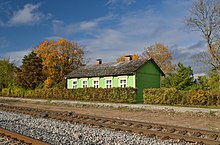Read
Lehtse ( German Lehtis or Lechts ) is a village ( alevik ) in the rural municipality of Tapa in the Estonian district of Lääne-Viru . Until 2005 Lehtse was a separate rural municipality in the Järva district ; then from the merger with the city of Tapa and the rural community of Saksi, the rural community of Tapa emerged. The village of Lehtse has 585 inhabitants (as of 2000).
Lehtse has a train station on the Tallinn - Tapa railway line, inaugurated in 1896 . The village itself came into being only after the Tallinn - Saint Petersburg railway was completed in 1870.
Lehtse is the birthplace of the Estonian politician Artur Sirk (1900–1937).
Lehtse manor house
The historical manor house of Lehtse ( Estonian Lehtse mõis ) is best known . It is about three kilometers from today's village center. In 1467 the master of the Teutonic Order transferred the estate to the Baltic German nobleman Hans von Lechtese. After the Great Northern War , the manor house belonged to the von Derfelden family and then to the von Rosen family . In 1780 a glass manufacture was founded on the estate . From 1868 to 1919 it was owned by Baron Friedrich Alexander Georg von Hoyningen-Huene , a well-known ornithologist and butterfly collector .
The manor's single-storey mansion was built in the early 19th century and rebuilt in the neo-Gothic style at the end of the 19th century . In 1919 the property was expropriated and became the property of the Estonian state. In 1933/34 the mansion was largely destroyed. The cellars are still preserved today. Two kilometers southwest of the manor house are the ruins of an old water mill on the upper reaches of the Soodla River .
Web links
- Full description (Estonian)
- Lehtse Manor (Estonian)
Coordinates: 59 ° 15 ' N , 25 ° 49' E
